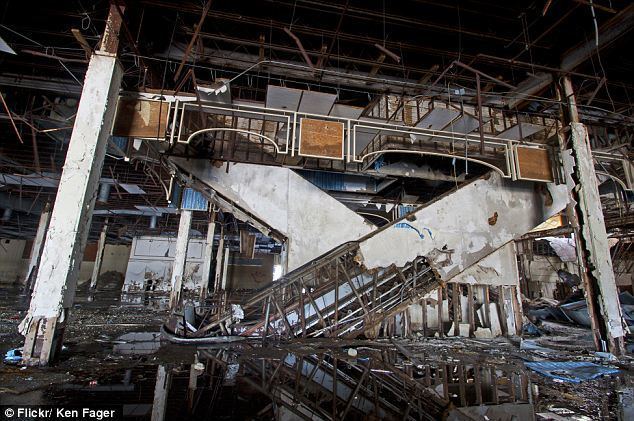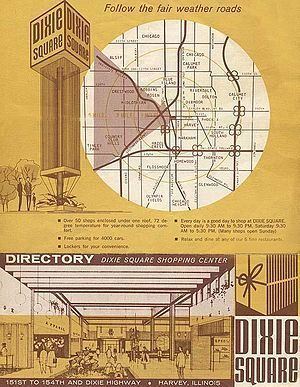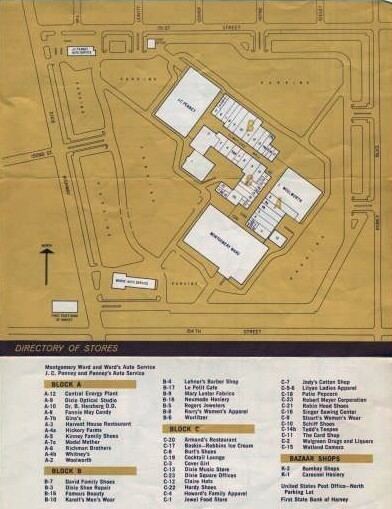No. of anchor tenants 3 Number of anchor tenants 3 | Opening date August 31, 1966 Opened 31 August 1966 | |
 | ||
Closing date November 1978(demolished February to May 2012) No. of stores and services 64 (in 1968)20 (in 1978) Similar Alton Square Mall, Rolling Acres Mall, Randall Park Mall, Hawthorne Plaza Shopping, Lincoln Mall | ||
Dixie square mall before and after
Dixie Square Shopping Center was an enclosed shopping mall located in Harvey, Illinois, United States, at the junction of 151st Street and the Dixie Highway. It stood vacant for over 30 years, more than twice as long as it was in business. It was famous for having been used, both inside and out, for the mall chase scene in the movie The Blues Brothers. More recently, it achieved notoriety because of a growing Internet cult following (including local urban exploration groups) dedicated to covering the mall's deteriorating condition. Like other "dead malls", it had been characterized by high vacancy rates and low patronage, which led to its closure. However, while other dead malls were redeveloped or demolished, Dixie Square stood out due to its extensive neglect, vandalism damage, and sordid history.
Contents
- Dixie square mall before and after
- Dixie square mall 10 16 2010
- Operation
- Temporary school and movie set
- Abandoned seeking uses
- Early plans
- Complications
- Demolition plans resume
- Finally demolished
- References

Since the mall closed in 1978, numerous plans had been proposed to demolish or redevelop the property, though most never came to fruition. The first plan to demolish the mall was developed in the late 1970s, but the filming of The Blues Brothers prevented this from happening. The mall was then left to decay, due in no small part to a lack of funds. For some time, the only parts of the mall that had been fully demolished were the central energy plant, the former Woolworth anchor, and the former Montgomery Ward building. Final demolition began in February 2012 and was completed in May of that year.

Dixie square mall 10 16 2010
Operation
At the cost of US$25 million, Dixie Square opened in 1966 on the site of a former golf course. Construction had begun in late 1964, and Montgomery Ward was the first of the mall's stores to open, on October 21, 1965. A soft opening took place August 31, 1966, with 36 stores. Construction was completed nearly three months later, and the mall was dedicated on November 9, 1966, with grand opening celebrations from November 10–12, and 50 stores open. Grand opening celebrations featured Homer and Jethro, Art Hodes and Sid Sakowicz, the Art Van Damme Quintet, and Ned Locke of the Bozo's Circus show. The mall had 64 shops by 1968, including the two anchor stores, Woolworth, Walgreens, and a Jewel supermarket. In 1970, Turn Style was added as another anchor.

However, by the early 1970s, crime was becoming an increasing problem in the mall's town of Harvey, a failing, poverty-stricken suburb 20 miles (32 km) south of Chicago, and several major incidents occurred at or near the mall, including three murders in one year alone. In November 1972, a young woman was fatally shot near the mall in a botched robbery attempt. On April 20, 1973, another person was shot and killed in a robbery on the mall property itself. On July 17, 1973, a teenage girl was lured away from the mall by three other teenage girls, and strangled to death. From 1973 to 1976, Dixie lost many stores, including the Montgomery Ward anchor, which closed on October 4, 1976 and Turn Style which closed in January 1978 (the entire chain would close). In a last-ditch effort to bring back shoppers and tenants, the mall underwent a renovation in 1976 and shortened its name to simply Dixie Mall. These efforts failed, as by 1978, it was down to its final twenty stores, with JCPenney departing in January.

The entire mall closed its doors in November 1978. On January 25, 1979, J. C. Penney briefly reopened and held a sale which they called "Dixie's Last Gasp", in which they liquidated outdated merchandise, mannequins, and display cases.
Temporary school and movie set

In January 1979, two months before Walgreens vacated, after the mall's interior had closed, the city of Harvey gave the part of the property not still in use by stores to the Harvey-Dixmoor School District. The mall space was used as a temporary school while a new one was constructed. Turn Style's floor space was used as a gymnasium. The mall was used for this purpose for two years.

Shortly after Jewel vacated in the summer of 1979, director John Landis rented the vacant mall for eight weeks in the summer of 1979 to film a scene in the movie The Blues Brothers. In the film, main characters Elwood and Jake Blues drive through storefronts, display cases and walls and destroy much of the mall while being chased by Illinois State Police troopers. Some former tenants, including Hickory Farms and Walgreens, refused to let their storefronts appear in the film so these were either "dressed up" as other stores or not featured at all. For example, the Walgreens became a Toys "R" Us, and the JCPenney interior became that of Jewel, although the exteriors of the real Jewel and JCPenney stores were retained. (The Jewel store never had a mall entrance.) Much of the mall interior was left in poor condition after filming wrapped. The fake wall that the cars crashed through in Toys "R" Us at the beginning of the scene remained in the building until the mid-1980s.
The Harvey-Dixmoor School District attempted to sue Universal Pictures in December 1981 for $87,000, citing damage to mall property created during the movie shoot, which was never repaired. The district eventually vacated the property, and the mall was completely shuttered.
Abandoned, seeking uses
After the mall's abandonment, it experienced extensive neglect and damage from vandalism. Following the movie shoot and the departure of the school district, the mall sat completely empty while new uses for the property were sought. The town of Harvey, which by now owned the mall, did not have the funds to maintain it. In 1984, vandals broke in for the first time, damaging and looting the mall, and leaving a number of entrances wide open in the process. Every accessible pane of glass in the mall was broken. Within a year, any piece of metal worth salvaging had been stolen. Also, around this time, the large triangular "Dixie" sign, added in the 1976 renovation and seen in the Blues Brothers film, was removed. The canvas covering the JCPenney court area was removed as well, allowing rain and snow to enter into the building. Over time, this, coupled with lack of maintenance, took its toll on the building.
In approximately 1985, the Wards Auto Service garage in the southwest corner of the mall property was razed, in preparation for construction of a new police station for Harvey. Work was temporarily halted on July 9, 1987 (at about 35% completion) while concerns about the building's foundation were addressed; work on the police station resumed a week later.
Despite the new Harvey Police station occupying land immediately adjacent, the shuttered mall gained a reputation as a notorious crime magnet during the early 1990s. Gang and drug activities frequently took place inside the former mall. In the early 1990s, a juvenile court was built on the far west end of the parking lot. Despite numerous attempts to board up and secure the mall, it was forced open repeatedly. Vandalism was the primary cause, but many homeless people also turned the former mall site into makeshift living quarters. In 1993, a woman was raped and fatally strangled inside the ruins of the mall.
By the end of the 1990s, trees had grown throughout the former parking lot. In the mid-2000s, a massive fire broke out inside the Woolworth store and nearly destroyed the building. The fire caused the roof to cave in, and due to that and other structural collapses, saplings started growing inside the building. Another fire broke out in the former City Life lounge, causing minor damage to the abandoned bar.
Early plans
Redevelopment plans were announced as early as 1997. In January 2005, an agreement was made with American Kitchen Delights to turn the former Montgomery Ward building into a showroom for American Kitchen's products, with the YMCA then using another portion of the property to build senior citizen housing. Just days after the agreement was made, work on the Montgomery Ward store began. The store was gutted.
On April 14, 2005, a plan was set in motion to demolish the remnants of Dixie Square (except for the Montgomery Ward building which was ostensibly being renovated) and bring top "big-box" retailers to the former mall site, including Costco, Kohl's, and Old Navy. This plan forecast bringing more than 1,000 jobs to Harvey, which has one of the highest unemployment rates in Cook County.
Complications
Soon, it was found the mall contained asbestos. The removed debris was haphazardly covered in plastic and the Montgomery Ward renovation and mall demolition were halted in late June 2005. It was also discovered that the demolition and renovation company had acted without a permit. On July 3, 2005, the site renovation project was put on hold until the asbestos issue could be dealt with. On Christmas Eve 2005, during demolition of Dixie Square Mall's central energy plant (which was being done late at night and illegally, as the asbestos problem had not been resolved), a large portion of the Montgomery Ward building was accidentally demolished as well, ending any chance of its renovation. The mayor of Harvey actually witnessed this personally and stopped the crew from doing any further damage, when he happened to drive past the site.
On February 16, 2006, the entire mall property was sold to developer John Deneen of the Emerald Property Group. The remainder of the Montgomery Ward building was torn down March 1 in a widely publicized stunt, but no progress was made to demolish the rest of the mall afterwards. After the news crews left, so did the demolition companies. Within several months of the Montgomery Ward demolition, liens were placed against the building by several invested companies. Deneen himself threatened the owner of one of these companies with brass knuckles and a firearm (he pleaded guilty in 2008 to aggravated unlawful use of a weapon). Attorney General Lisa Madigan also filed lawsuits against Deneen and several previous developers for failing to remove the asbestos in accordance with state law.
On July 20, 2009, a fire of unknown origin broke out in the entrance to Block C during the late afternoon. The fire damaged the Block C entrance to the point where its roof collapsed within a month, and left scorch marks on the exterior of the former JC Penney building.
Demolition plans resume
In February 2010 it was reported that Chicago-based developers MG Development South LLC were planning to demolish the remains of the mall and replace them with a mixture of big-box stores and other retail on the site.
On September 23, 2010, Governor Pat Quinn announced that a $4 million federal grant would be used to demolish the mall. Gov. Quinn also stated that the total cost will be around $5 million, with the remainder of the money coming from federal disaster recovery funds given to the state due to flooding in 2008. According to officials, demolition was to start in November and take four to six months. In June 2011, ruins of the mall remained standing with demolition funding still available, but with the demolition project itself mired in government regulatory hurdles.
Finally demolished
In January 2012, contractors were finally issued the necessary permits to begin demolition. After several weeks of asbestos removal, which was completed by early February, the actual demolition process began on Wednesday, February 15, as crews started to demolish the mall. The final part of the mall (J.C. Penney) was demolished May 17, 2012. Following the demolition of the mall, the site was cleaned up and leveled in preparation for future development.
The vast majority of the former site is now brownfield land. A November 2015 article suggests that the land has been proposed for development as an intermodal freight site.
